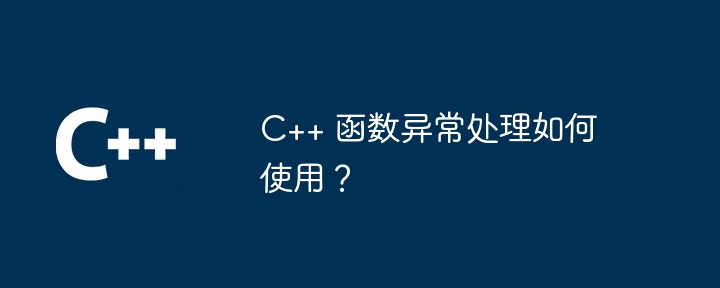
Exception handling is a mechanism for handling function errors, captured using try-catch syntax: the try block contains code that may cause an exception. The catch block catches exceptions of a specific type, use exception_type &e to access the exception object. catch (...) catches any type of exception. For example, when converting a string to an integer, invalid arguments raise an invalid_argument exception, and out-of-range raises an out_of_range exception.

Exception handling is a technique for handling errors or exceptions that occur within a function. It allows you to handle errors gracefully without crashing the entire program.
Exception handling uses the following syntax:
try {
// 执行可能引发异常的代码
} catch (exception_type &e) {
// 捕获特定类型的异常
} catch (...) {
// 捕获任何类型的异常
}try The block contains code that may throw an exception. catch block is used to catch specific types of exceptions. It uses the parameter exception_type &e to access the exception object. catch (...). Let's look at a practical example of using exception handling:
#include <iostream>
#include <string>
using namespace std;
int main() {
try {
// 将字符串转换为整数
int num = stoi("abc");
} catch (invalid_argument &e) {
// 处理无效参数异常
cout << "Invalid integer: " << e.what() << endl;
} catch (out_of_range &e) {
// 处理超出范围异常
cout << "Out of range: " << e.what() << endl;
} catch (...) {
// 处理任何其他异常
cout << "Unknown error occurred." << endl;
}
return 0;
}In this case, we try to "abc" Convert to integer. If the string does not contain a valid integer, it will raise an invalid_argument exception. Alternatively, if the value is outside the int range, an out_of_range exception is thrown. We use exception handling to catch these exceptions and handle them gracefully.
The above is the detailed content of How to use C++ function exception handling?. For more information, please follow other related articles on the PHP Chinese website!
 What are the differences between c++ and c language
What are the differences between c++ and c language
 Recommended learning order for c++ and python
Recommended learning order for c++ and python
 Cost-effectiveness analysis of learning python and c++
Cost-effectiveness analysis of learning python and c++
 Is c language the same as c++?
Is c language the same as c++?
 Which is better to learn first, c language or c++?
Which is better to learn first, c language or c++?
 The difference and connection between c language and c++
The difference and connection between c language and c++
 C++ software Chinese change tutorial
C++ software Chinese change tutorial
 Cost-effectiveness analysis of learning python, java and c++
Cost-effectiveness analysis of learning python, java and c++




